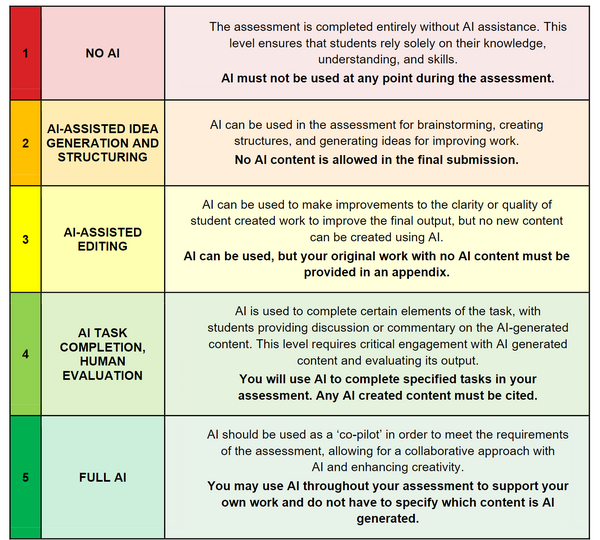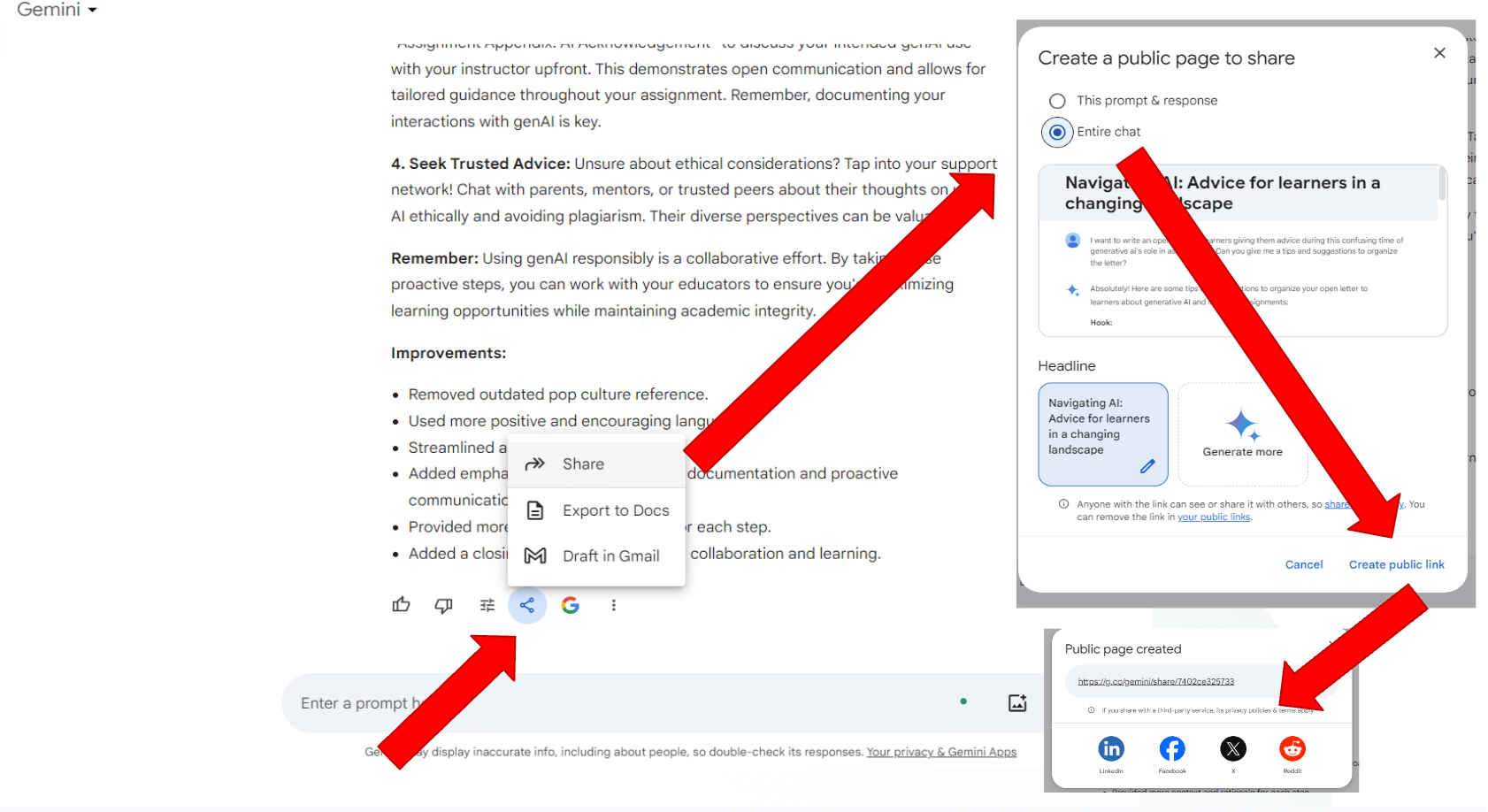AI for Teaching and Learning |
Enhancing Assignments with AI Transparency
Introduction
Balancing the use of advanced AI tools with maintaining academic integrity is a growing concern in education. Understanding how to transparently integrate AI into assignments is essential for promoting academic integrity and preventing misuse.
Guiding Principles
Clarity of Generative AI Usage: Effective communication of how and to what extent students are allowed to use generative AI is crucial. Feedback from both faculty and students indicates significant confusion regarding AI usage. This issue isn't unique to our campus; national surveys reveal that students often lack clarity about what is permissible. It's our responsibility as instructors to address this ambiguity clearly, assignment by assignment.
Expectation of Documentation: If you decide that AI could or should be integrated into your assessments, it's important to set clear expectations for students to "show their work." This includes proper citations and sharing their chat prompting process.
Supportive Tools and Implementation Tips
Generative AI Acceptable Use Scale: This framework has become prominent in literature over the past year. It was designed to:
- Help educators adjust assessments in light of generative AI tools.
- Clarify to students how and where generative AI tools might be used in their work.
- Support students in completing assessments in line with academic integrity principles.

Figure 1: Generative AI Acceptable Use Scale (Perkins et al, 2024)
The scale categorizes AI usage into clear levels:
- Prohibited: No AI use allowed for assignments.
- Limited Use: AI can assist with minor tasks like grammar checks.
- Moderate Use: AI is permitted for idea generation or outlining but not final content creation.
- Full Use with Documentation: Extensive AI use is allowed if documented and cited.
- Full Use with Human Oversight: AI can be fully utilized under close instructor supervision.
Examples of Disciplinary Applications: See this handout with disciplinary examples demonstrating the application of AIAS at different levels. For example:
- Level 1: In computer science, students demonstrate theoretical knowledge through in-person class discussions and paper-based coding exams.
- Level 3: In the social sciences, students use AI tools like Geni to refine presentation language for clarity.
Expectations for Documentation
Students need to develop two key AI literacies to ethically document AI use:
- Citation: Knowing how to properly cite AI tools. Direct students to our library's website for comprehensive guides on major citation styles, including APA, Chicago, and MLA. The library also offers email and chat support to help students navigate these new literacies.
- Documentation: Sharing prompt threads or entire chats. For documenting prompts, responses, or entire chat threads, students should publish and share links. When teaching this skill, one student remarked with visible relief, "This makes me feel less icky using AI. It's like turning in my scrap paper for a math test—this shows my work.

Figure 2: Example of how to share a chat thread in Google Gemini
Implementation Tools and Tips
Sample Assignment Guide: Include a section on generative AI assignment expectations in your guides. This section should cover:
- Permissions and Acknowledgments: Clearly state the extent of AI use allowed.
- Citation Style: Specify the required citation format.
- Documentation: Encourage students to provide links or screenshots of AI-generated content.
- Acceptable Use: Use the AIAS to inform students of permissible AI tasks.
Here is an example:
genAI Assignment Expectations:
Permission and Acknowledgment: Students are required to use genAI Only with Acknowledgement. The “Assignment Appendix: AI Acknowledgement” must be included in the appendix of the assignment to detail the extent and nature of AI assistance received.
Citation: Adherence to the MLA citation format is required for all paraphrased content, direct quotations, references to creative visual works, and citations of secondary sources consulted by the AI tool.
Documentation: Students are encouraged to provide a shared link to a chat response or the whole thread, the AI-generated content or conversation thread as part of their submission. Alternatively, screenshots capturing the relevant AI interactions are acceptable. This documentation should be clear and accessible to ensure transparency and ease of verification.
Acceptable Use: According to the “Generative AI Acceptable Use Scale,” students are allowed to utilize generative AI up to Level 3 for Specified Task Completion. Authorized and recommended tasks for this assignment include: idea generation and structuring, editing (spelling, grammar, adjusting tone to audience, conciseness), and specified task completion (literature review/research). If there are additional tasks you wish to use generative AI for, please discuss them with the instructor in advance.
Assignment Appendix for AI Acknowledgement: This is a tool that ensures students transparently disclose and reflect on their use of generative AI in assignments. It includes two parts: a pledge to follow AI usage guidelines and prompts students to document their AI interactions with reflections on how AI influenced their work. The template, in whole or in part, should be regularly discussed with students during all or at least the earlier assignments.
For the Google Doc template, you can copy and adapt the following:
Assignment Appendix for AI Acknowledgement
Conclusion
AI's role in assignments doesn't have to be all or nothing, but it does need to be transparent. By adopting these guidelines and tools, you can enhance the quality and integrity of student work while ensuring that AI is used ethically and effectively in your assignments.
Next Steps
- Assignment-by-Assignment Review: Define acceptable AI use for each assessment.
- Integrating AI Skills: Incorporate AI skills and literacies into teaching practices and assignment expectations.
Related Resources:
- Watch the video companion to this article
- Access the slide deck companion
References
Perkins, M., Furze, L., Roe, J., & MacVaugh, J. (2024). The Artificial Intelligence Assessment Scale (AIAS): A framework for ethical integration of generative AI in educational assessment. Journal of University Teaching and Learning Practice, 21(06). https://open-publishing.org/journals/index.php/jutlp/article/view/810/769